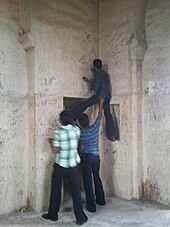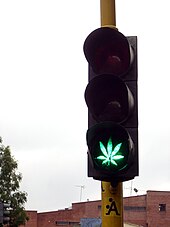Progression of Vandalism as seen in a men’s employee bathroom at a grocery store
Vandalism is the action involving deliberate destruction of or damage to public or private property.[1]
The term includes property damage, such as graffiti and defacement directed towards any property without permission of the owner. The term finds its roots in an Enlightenment view that the Germanic Vandals were a uniquely destructive people.
Vandalism on a street sign, making it read “i Swim in Poo”
Etymology
Vandalised park bench in Zarqa
The Vandals, an ancient Germanic people, are associated with senseless destruction as a result of their sack of Rome under King Genseric in 455. During the Enlightenment, Rome was idealized, while the Goths and Vandals were blamed for its destruction. The Vandals may not have been any more destructive than other invaders of ancient times, but they did inspire English poet John Dryden to write, Till Goths, and Vandals, a rude Northern race, Did all the matchless Monuments deface (1694). However, the Vandals did intentionally damage statues, which may be why their name is associated with the vandalism of art. The term Vandalisme was coined in 1794 by Henri Grégoire, bishop of Blois, to describe the destruction of artwork following the French Revolution. The term was quickly adopted across Europe. This new use of the term was important in colouring the perception of the Vandals from later Late Antiquity, popularizing the pre-existing idea that they were a barbaric group with a taste for destruction.[2]
Vandalism on a sign in front of a high school pool entrance, reading: «POO BACON»
Historically, vandalism has been justified by painter Gustave Courbet as destruction of monuments symbolizing «war and conquest». Therefore, it is often done as an expression of contempt, creativity, or both. Courbet’s attempt, during the 1871 Paris Commune, to dismantle the Vendôme column, a symbol of the past Napoleon III authoritarian Empire, was one of the most celebrated events of vandalism. Nietzsche himself would meditate after the Commune on the «fight against culture», taking as example the intentional burning of the Tuileries Palace on 23 May 1871. «The criminal fight against culture is only the reverse side of a criminal culture» wrote Klossowski after quoting Nietzsche.[3]
In a proposal to the International Conference for Unification of Criminal Law held in Madrid in 1933, Raphael Lemkin envisaged the creation of two new international crimes (delicta juris gentium): the crime of barbarity, consisting in the extermination of racial, religious, or social collectivities, and the crime of vandalism, consisting in the destruction of cultural and artistic works of these groups.[4] The proposal was not accepted.
As a crime
Vandalized shooting stand in Germany
Private citizens commit vandalism when they willfully damage or deface the property of others or the commons. Some vandalism may qualify as culture jamming or sniggling: it is thought by some to be artistic in nature even though carried out illegally or without the property owner’s permission. Examples include at least some graffiti art, billboard «liberation», and possibly crop circles. Criminal vandalism takes many forms. Graffiti on public property is common in many inner cities as part of a gang culture, where they might be used as territorial markers.[5]
More serious forms of vandalism that may take place during public unrest such as rioting can involve the willful destruction of public and private property. Vandalism per se is sometimes considered one of the less serious common crimes, but it can become quite serious and distressing when committed extensively, violently, or as an expression of hatred and intimidation. In response, local governments have adopted various legal measures to prevent vandalism, but research has shown that the conventional strategies employed by the government in response to at least unapproved graffiti are not the most effective.[6]
Examples
Examples of vandalism include salting lawns, cutting trees without permission, egg throwing, breaking windows, arson, spraying paint on others’ properties, tagging, placing glue into locks, tire slashing, keying (scratching) paint, ransacking a property, flooding a house by clogging a sink and leaving the water running, and pulling up plants from the roots without permission.
Political
Armand Călinescu’s memorial with the bronze plaque stolen and the name of the assassin written over
In elections, opposing candidates’ supporters may engage in «political vandalism»—the act of defacing opponents’ political posters, bumper stickers, billboards, and other street marketing material. Although the nature of this material is temporary, its effect can be long-lasting as it may reflect both negatively and positively on the candidate whose material is being vandalized as well as on the presumed candidate whose supporters are engaging in the vandalism.
In addition, activists may use the tactic of property destruction[7] as means of protest, e.g. by smashing the windows of banks, shops and government institutions and setting fire to cars. This often takes place during riots but can also happen as a stand-alone event, e.g. by animal rights activists destroying property owned by farmers, hunters, biotech companies, and research facilities and setting free animals (which is sometimes referred to as eco-terrorism by opponents). Vandalism is also a common tactic of black blocs.
Motives
Actions of this kind can be ascribed to anger or envy, or to spontaneous, opportunistic behaviour, possibly for peer acceptance or bravado in gang cultures, or disgruntlement with the target (victim) person or society. Another common motive is to seek attention, and for personal gain. Opportunistic vandalism of this nature may also be filmed, the mentality of which can be akin to happy slapping. The large-scale prevalence of gang graffiti in some inner cities has almost made it acceptable to the societies based there, so much so that it may go unnoticed, or not be removed, possibly because it may be a fruitless endeavour, to be graffitied on once again. Greed can motivate vandalism as can some political ideologies, wish to draw attention to problems, frustration, even playfulness. Youngsters, the most common vandals, frequently experience low status and boredom. Vandalism enables powerless people to attack those above them, take control and frighten others. Unpunished vandalism can provide relief which reinforces the behaviour. Vandalism by one person can lead to imitation.[8] Teenage boys and men in their 20s are most likely to vandalize, but older adults and females are also known to sometimes vandalize, with young children occasionally vandalizing, but in a much smaller form, such as making small crayon drawings on walls.[citation needed]
Modern graffiti on the Achaemenid era rock relief of Rawansar tomb, Iran
Criminological research into vandalism has found that it serves many purposes for those who engage in it and stems from a variety of motives. Sociologist Stanley Cohen describes seven different types of vandalism:[9]
- Acquisitive vandalism (looting and petty theft).
- Peer pressure – Teenagers spend more time away from home with peers, and whether they act constructively or destructively can depend on the contacts they make. Disobeying authority can appear cool.
- Tactical vandalism (to advance some end other than acquiring money or property – such as breaking a window to be arrested and get a bed for the night in a police cell).
- Ideological vandalism (carried out to further an explicit ideological cause or deliver a message).
- Vindictive vandalism (for revenge).
- Play vandalism (damage resulting from children’s games).
- Malicious vandalism (damage caused by a violent outpouring of diffuse frustration and rage that often occurs in public settings).[10] Cohen’s original typology was improved upon by Mike Sutton[11] whose research led him to add a seventh sub-type of vandalism – Peer Status Motivated Vandalism.[12]
Two billboards with the same original content, the billboard on the right being an example of subvertising—vandalizing with a political message
In view of its incivility, punishment for vandalism can be particularly severe in some countries. In Singapore, for example, a person who attempts to cause or commits an act of vandalism may be liable to imprisonment for up to 3 years and may also be punished with caning. Vandalism in the UK is construed as an environmental crime and may be punished with an ASBO (Anti-Social Behaviour Order).
In the 1990s, former New York City mayor Rudolph Giuliani cracked down on «quality of life crimes», including graffiti. NY Parks Commissioner Henry J. Stern described graffiti as «a metaphor for urban decay perhaps best shown in ‘A Clockwork Orange'» adding that «New York City will not be like that».[13]
Cybervandalism
|
This section needs expansion. You can help by adding to it. (January 2015) |
Cybervandalism is vandalism on the internet. For example, vandalism on Wikipedia involves adding questionable content, removing content, or changing content in order to make it questionable, generally with the objective of harming Wikipedia’s reputation. Forms of online vandalism have been recorded, the most common of which is website defacement. Vandalism on web maps has been called «cartographic vandalism».[14]
Another form of cybervandalism is the creation of malware such as viruses, Trojan horses, and spyware, which can harm computers. A particularly virulent form of cybervandalism is ransomware, which is used to extort money from computer owners, and can even go so far as to carry a destructive malware payload that harms the system if payment isn’t forthcoming within a certain time limit.[citation needed]
Cybervandalism could be said to be a form of creativity and artistry. An example of this was when the Cheltenham paint festival was cancelled due to COVID-19, and artists still proceeded to celebrate their artistry virtually.[15]
Defacement
Defacement is a type of vandalism that involves damaging the appearance or surface of something. The object of damage may be architecture, books, paintings, sculpture, or other forms of art.[16]
Examples of defacement include:
- Marking or removing the part of an object (especially images, be they on the page, in illustrative art or as a sculpture) designed to hold the viewers’ attention
- Scoring a book cover with a blade
- Splashing paint over a painting in a gallery
- Smashing the nose of a sculpted bust
- Damaging or chiselling off sculpted coats of arms
- Altering the content of web sites and publicly editable repositories to include nonsensical or whimsical references
Iconoclasm led to the defacement of many religious artworks.
As art
A sticker reading «The HELL with SHELL» photographed in Michigan in 1973
Though vandalism in itself is illegal, it is often also an integral part of modern popular culture. French painter Gustave Courbet’s attempt to disassemble the Vendôme column during the 1871 Paris Commune was probably one of the first artistic acts of vandalism, celebrated at least since Dada performances during World War I. The Vendôme column was considered a symbol of the recently deposed Second Empire of Napoleon III, and dismantled as such.
After the burning of the Tuileries Palace on 23 May 1871, Philosopher Friedrich Nietzsche himself meditated about the «fight against culture», wondering what could justify culture if it were to be destroyed in such a «senseless» manner (the arguments are: culture is justified by works of art and scientific achievements; exploitation is necessary to those achievements, leading to the creation of exploited people who then fight against culture. In this case, culture cannot be legitimised by art achievements, and Nietzsche writes: «I {also} know what it means: fighting against culture». After quoting him, Klossowski writes: «The criminal fight against culture is only the reverse side of a criminal culture».[3]
As destruction of monument, vandalism can only have sense in a culture respecting history, archeology: Nietzsche spoke of monumental history. As destruction of monumental history, vandalism was assured a long life (as Herostratus proved): Performance art could make such a claim, as well as Hakim Bey’s poetic terrorism or Destroy 2000 Years of Culture from Atari Teenage Riot. Gustave Courbet’s declaration stated:
Attendu que la colonne Vendôme est un monument dénué de toute valeur artistique, tendant à perpétuer par son expression les idées de guerre et de conquête qui étaient dans la dynastie impériale, mais que réprouve le sentiment d’une nation républicaine, [le citoyen Courbet] émet le vœu que le gouvernement de la Défense nationale veuille bien l’autoriser à déboulonner cette colonne.[17]
(‘As the Vendôme column is a monument devoid of any artistic value, whose expression tends to perpetuate the ideas of war and conquest from the imperial dynasty, but that reject the sentiment of a republican nation, citizen Courbet declares that the government of National Defense should allow him to dismantle this column.)
Hence, painter Courbet justified the dismantlement of the Vendôme column on political grounds, downgrading its artistic value. Vandalism poses the problem of the value of art compared to life’s hardships: Courbet thought that the political values transmitted by this work of art neutralized its artistic value. His project was not followed; however, on 12 April 1871, the Commune voted to dismantle the imperial symbol, and the column was taken down on 8 May. After the assault on the Paris Commune by Adolphe Thiers, Gustave Courbet was condemned to pay part of the expenses.
In 1974, Norman Mailer glorified the art of vandalism in his essay «The Faith of Graffiti», which likened tagging in New York City to the work of Giotto and Rauschenberg. New York Authorities responded by coating subway walls with Teflon paint, jailing taggers and requiring hardware stores to keep spray paint under lock and key.[18]
Tags, designs, and styles of writing are commonplace on clothing, and are an influence on many of the corporate logos. Many skateparks and similar youth-oriented venues are decorated with commissioned graffiti-style artwork, and in many others patrons are welcome to leave their own. There is still, however, a fine line between vandalism as an artform, as a political statement, and as a crime. Bristol-born guerrilla artist Banksy’s claim is that official vandalism is far worse than that perpetrated by individuals, and that he is decorating buildings of no architectural merit.[19]
Graphic design
Defacing could also be one of the techniques that many graphic designers use, by applying their own hand writing on a graphic itself. Sometimes the use of this technique might be mistaken as vandalism to the original work, as exemplified by the work of Stefan Sagmeister, including his Lou Reed CD cover. A unique use of the defacement technique is the CD cover for A.P.C. by Jean Touitou, where the designer wrote the title, volume number, and date with her own hand writing on the pre-print blank CD. Creative vandalism of this sort is not limited to writing and sketching. For example, the spraying on the KPIST album Golden coat for MNW Records by Sweden graphic uses gold spray, which may be considered an act of vandalism, but the customer may also appreciate the unicity of each cover that had been sprayed gold in different ways.[20]
See also
- Abuse
- Broken windows theory
- Criminal mischief
- Graffiti
- Iconoclasm
- Latrinalia
- Library book vandalism
- Malicious mischief
- Vandalism of art
- Vandalism on Wikipedia
- Website defacement
References
- ^ «Oxford English Dictionary». Oxford University Press. Archived from the original on 31 July 2013. Retrieved 25 April 2015.
- ^ Merrills and Miles 2010, pp. 9–10.
- ^ a b See Pierre Klossowski, Nietzsche and the Vicious Circle, first Chapter: What is the value of culture if those who are exploited by it destroy it? «En sorte qu’il nous faut être bien loin de vouloir, du haut de notre sentiment de nous-mêmes, imputer le crime d’un combat contre la culture exclusivement à ces malheureux. Je sais ce que cela veut dire: le combat contre la culture. (…) je me campronnai avec une conviction sérieuse à la valeur métaphysique de l’art, lequel ne saurait exister à cause des pauvres gens, mais doit accomplir des missions plus hautes. Mais, en dépit de mon extrême douleur, je n’étais pas en état de jeter la moindre pierre à ces profanateurs qui, pour moi, n’étaient que les suppôts de la culpabilité universelle, sur laquelle il y a beaucoup à méditer!» Nietzsche quoted by Klossowski pp. 29–30 French edition, who adds: «Le combat criminel contre la culture n’est lui-même que l’envers d’une culture criminelle» («The criminal fight against culture is only the reverse side of a criminal culture»)
- ^ Raphael Lemkin: Akte der Barbarei und des Vandalismus als delicta juris gentium Archived 25 February 2021 at the Wayback Machine, Anwaltsblatt Internationales (Wien), November 1933.
- ^ Ley and Cybriwsky 1974.
- ^ J. Scott Armstrong (1978). «The Graffiti Solution» (PDF). The Wharton Magazine. Archived from the original (PDF) on 20 June 2010. Retrieved 23 January 2012.
- ^ Is it OK for protesters to damage property? Archived 14 January 2021 at the Wayback Machine, New Internationalist Magazine, issue 440
- ^ «Psychological Analysis of Vandalism». Archived from the original on 4 March 2016. Retrieved 29 March 2015.
- ^ Cohen 1973.
- ^ «The Psychological View of Why Children Vandalize». Archived from the original on 19 March 2015. Retrieved 29 March 2015.
- ^ «Center for Problem-Oriented Policing | Biographies». Popcenter.org. Archived from the original on 21 June 2010. Retrieved 10 December 2012.
- ^ Sutton, Mike (1987) Differential Rates of Vandalism in a New Town: Towards A Theory of Relative Place. Unpublished PhD Thesis, University of Central Lancashire, October
- ^ Hicks, Jonathan P. (17 November 1994). «Mayor Announces New Assault on Graffiti, Citing Its Toll on City». The New York Times. ISSN 0362-4331. Archived from the original on 9 March 2021. Retrieved 8 May 2018.
- ^ Ballatore 2014.
- ^ «Cheltenham Paint Festival goes virtual during lockdown». 12 May 2020. Archived from the original on 21 April 2021. Retrieved 21 April 2021.
- ^ Library of Congress; Library of Congress. Cataloging Policy and Support Office; Library of Congress. Subject Cataloging Division; Library of Congress. Office for Subject Cataloging Policy (1996). Library of Congress subject headings. Library of Congress. p. 1430. Archived from the original on 7 March 2023. Retrieved 17 November 2012.
- ^ «La Colonne Vendôme déboulonnée» (in French). Archived from the original on 3 March 2016. Retrieved 4 August 2007.
- ^ «Fine Art, Sí, Vandalism, No». Archived from the original on 14 May 2011. Retrieved 29 October 2008.
- ^ D.E. Funk (7 October 2013). «Banksy the Artist». www.Medium.com. Medium-All things art. Archived from the original on 21 October 2022. Retrieved 21 October 2022.
- ^ Odling-Smee Anne (2002) the new handmade graphics: Beyond digital design. RotoVision SA
Other References
- Ballatore, A. (2014), «Defacing the map: Cartographic vandalism in the digital commons», The Cartographic Journal, 51 (3): 214–224, arXiv:1404.3341, doi:10.1179/1743277414y.0000000085, S2CID 1828882
- Cohen, S. (1973), Ward, C. (ed.), Property destruction: Motives and meanings, London: Architectural Press, pp. 23–53
- Goldstein, A. (1996), The Psychology of Vandalism, New York: Plenum Press
- Ley, D. & Cybriwsky, R. (1974), «Urban Graffiti as Territorial Markers», Annals of the Association of American Geographers, 64 (4): 491–505, doi:10.1111/j.1467-8306.1974.tb00998.x
- Merrills, A.; Miles, R. (2010), The Vandals, John Wiley & Sons, ISBN 978-1-4051-6068-1
- Williams, M. (2006), Virtually Criminal: Crime, Deviance, and Regulation Online., Abington, UK: Taylor & Francis
Bibliography
- Chris Hammond. Bank. Retrieved 9 March 2016
External links
: willful or malicious destruction or defacement of public or private property
Synonyms
Example Sentences
acts of theft and vandalism
He was arrested for vandalism.
Recent Examples on the Web
Hate crimes were spiking nationwide in January 2020 when Oregon became one of the first states to launch a hotline for victims of violence, harassment or vandalism rooted in bigotry.
—
The non-profit organization tallied 3,697 instances of assault, harassment or vandalism last year, marking the highest number on record since the group began its annual audit in 1979.
—
The report tracked 3,697 incidents of harassment, vandalism and assault aimed at Jewish people and communities last year.
—
The report tracked 3,697 incidents of harassment, vandalism and assault aimed at Jewish people and communities last year.
—
The report tracked 3,697 incidents of harassment, vandalism and assault aimed at Jewish people and communities last year.
—
Antisemitic incidents involving harassment, vandalism and assaults surged in Southern California and the rest of the state in 2022, according to a new report by the Anti-Defamation League.
—
The incidents including assault, vandalism and harassment increased by more than a third in just one year and reached nearly 3,700 cases in 2022, a new ADL report published Thursday found.
—
Drivers are now paying $2,014 a year on average, according to a Bankrate.com study that examined comprehensive policies (which cover risks in addition to collisions such as vandalism and windshield damage).
—
See More
These examples are programmatically compiled from various online sources to illustrate current usage of the word ‘vandalism.’ Any opinions expressed in the examples do not represent those of Merriam-Webster or its editors. Send us feedback about these examples.
Word History
First Known Use
1798, in the meaning defined above
Time Traveler
The first known use of vandalism was
in 1798
Dictionary Entries Near vandalism
Cite this Entry
“Vandalism.” Merriam-Webster.com Dictionary, Merriam-Webster, https://www.merriam-webster.com/dictionary/vandalism. Accessed 13 Apr. 2023.
Share
More from Merriam-Webster on vandalism
Last Updated:
8 Apr 2023
— Updated example sentences
Subscribe to America’s largest dictionary and get thousands more definitions and advanced search—ad free!
Merriam-Webster unabridged
van·dal·ism
(văn′dl-ĭz′əm)
n.
Willful or malicious damage or destruction of the property of another.
van′dal·is′tic adj.
American Heritage® Dictionary of the English Language, Fifth Edition. Copyright © 2016 by Houghton Mifflin Harcourt Publishing Company. Published by Houghton Mifflin Harcourt Publishing Company. All rights reserved.
vandalism
(ˈvændəˌlɪzəm)
n
the wanton or deliberate destruction caused by a vandal or an instance of such destruction
ˌvandalˈistic, ˈvandalish adj
Collins English Dictionary – Complete and Unabridged, 12th Edition 2014 © HarperCollins Publishers 1991, 1994, 1998, 2000, 2003, 2006, 2007, 2009, 2011, 2014
van•dal•ism
(ˈvæn dlˌɪz əm)
n.
1. deliberate destruction or damage of private or public property.
2. the conduct or spirit characteristic of the Vandals.
[< French vandalisme (1793)]
van`dal•is′tic, van′dal•ish, adj.
Random House Kernerman Webster’s College Dictionary, © 2010 K Dictionaries Ltd. Copyright 2005, 1997, 1991 by Random House, Inc. All rights reserved.
vandalism
the malicious destruction or defamation of public or private property. — vandal, vandalization, n. — vandalish, adj.
See also: Behavior
-Ologies & -Isms. Copyright 2008 The Gale Group, Inc. All rights reserved.
ThesaurusAntonymsRelated WordsSynonymsLegend:
| Noun | 1. |  vandalism — willful wanton and malicious destruction of the property of others vandalism — willful wanton and malicious destruction of the property of others
destruction, devastation — the termination of something by causing so much damage to it that it cannot be repaired or no longer exists |
Based on WordNet 3.0, Farlex clipart collection. © 2003-2012 Princeton University, Farlex Inc.
Translations
vandalismusvandalství
vandalisme
vandalism
vandalismi
vandalizam
vandalizmus
vandalismi, skemmdarverk
破壊行為荒らし
공공시설 파괴 행위
vandalstvo
vandalizem
vandalism
การทำลายทรัพย์สิน
hành động cố ý phá hoạiphá hoại
Collins Spanish Dictionary — Complete and Unabridged 8th Edition 2005 © William Collins Sons & Co. Ltd. 1971, 1988 © HarperCollins Publishers 1992, 1993, 1996, 1997, 2000, 2003, 2005
Collins English/French Electronic Resource. © HarperCollins Publishers 2005
vandalism
Collins German Dictionary – Complete and Unabridged 7th Edition 2005. © William Collins Sons & Co. Ltd. 1980 © HarperCollins Publishers 1991, 1997, 1999, 2004, 2005, 2007
Collins Italian Dictionary 1st Edition © HarperCollins Publishers 1995
vandal
(ˈvӕndəl) noun
a person who purposely and pointlessly damages or destroys public buildings or other property. Vandals have damaged this telephone kiosk.
ˈvandalism noun
the behaviour of a vandal. All the telephones are out of order owing to vandalism.
ˈvandalize, ˈvandalise verb
The lift in our block of flats has been vandalized.
Kernerman English Multilingual Dictionary © 2006-2013 K Dictionaries Ltd.
vandalism
→ تَخْرِيب vandalismus vandalisme Vandalismus βανδαλισμός vandalismo vandalismi vandalisme vandalizam vandalismo 破壊行為 공공시설 파괴 행위 vandalisme vandalisme wandalizm vandalismo вандализм vandalism การทำลายทรัพย์สิน vandalizm hành động cố ý phá hoại 破坏公物行为
Multilingual Translator © HarperCollins Publishers 2009
Other forms: vandalisms
Vandalism is the destruction of someone else’s property. Some people think of graffiti as public art, while others dismiss it as nothing but vandalism.
If you damage public or private property on purpose, you’ve committed the crime of vandalism. The range of vandalism can vary from carving your initials in a desk at school to tearing pages out of a library book to breaking windows of a building. The word vandal comes from the Vandals, the Germanic tribe that attacked Rome in 455. The tribe’s name meant «wanderer,» but the word vandal was used in the 1600s to mean «destroyer of what is beautiful.»
Definitions of vandalism
-
noun
willful wanton and malicious destruction of the property of others
-
synonyms:
hooliganism, malicious mischief
see moresee less-
type of:
-
destruction, devastation
the termination of something by causing so much damage to it that it cannot be repaired or no longer exists
-
devilment, devilry, deviltry, mischief, mischief-making, mischievousness, rascality, roguery, roguishness, shenanigan
reckless or malicious behavior that causes discomfort or annoyance in others
-
destruction, devastation
DISCLAIMER: These example sentences appear in various news sources and books to reflect the usage of the word ‘vandalism’.
Views expressed in the examples do not represent the opinion of Vocabulary.com or its editors.
Send us feedback
EDITOR’S CHOICE
Look up vandalism for the last time
Close your vocabulary gaps with personalized learning that focuses on teaching the
words you need to know.
Sign up now (it’s free!)
Whether you’re a teacher or a learner, Vocabulary.com can put you or your class on the path to systematic vocabulary improvement.
Get started
Meaning VANDALISM
What does VANDALISM mean? Here you find 39 meanings of the word VANDALISM. You can also add a definition of VANDALISM yourself
1 |
0 1794, from French vandalisme, first used by Henri Grégoire, Bishop of Blois, in a report decrying the pillage and destruction of art in the course of the French Revolution; see vandal + -ism.
|
2 |
0 VANDALISMDestruction or spoiling of property for criminal intent.
|
3 |
0 VANDALISMwillful wanton and malicious destruction of the property of others (vandal) someone who willfully destroys or defaces property (vandal) a member of the Germanic people who overran Gaul and Spain and N [..]
|
4 |
0 VANDALISMnoun. purposeful defacement or disassembly of property. A continual trend of vandalism is one indication of conduct disorder.
|
5 |
0 VANDALISMDamage to library collections, furnishings, or facilities that is intentional rather than accidental, usually motivated by anger or malice on the part of the perpetrator (see this example). Vandalism [..]
|
6 |
0 VANDALISMthe willful or malicious destruction or defacement of property [insurance covering property damage from and malicious mischief]
|
7 |
0 VANDALISMVandalism is something that no one wants to deal with. It costs the vending industry millions of dollars a year. It usually makes the vending machine unusable for a period of time. Vandalism can easil [..]
|
8 |
0 VANDALISMVandalism is typically defined as when a person knowingly causes serious physical damage to a structure or its contents. Vandalism is governed by state statutes, which vary by state. Some states have [..]
|
9 |
0 VANDALISM(n) willful wanton and malicious destruction of the property of others
|
10 |
0 VANDALISMDestruction or defacement of property.
|
11 |
0 VANDALISMThe willful physical damage to a property.
|
12 |
0 VANDALISMDestruction or defacement of property.
|
13 |
0 VANDALISMThe malicious and often random destruction or spoilage of another personís property.
|
14 |
0 VANDALISMWillful or malicious destruction or defacement of public or private property.
|
15 |
0 VANDALISMThe malicious destruction of property.
|
16 |
0 VANDALISMWilful destruction of property
|
17 |
0 VANDALISMThe malicious and often random destruction or spoilage of another person's property.
|
18 |
0 VANDALISMThe malicious destruction of another person’s property.
|
19 |
0 VANDALISMThe malicious and often random destruction or spoilage of another person’s property.
|
20 |
0 VANDALISMUsed synonymously with malicious mischief; willful physical damage to property.
|
21 |
0 VANDALISMThe malicious and often random destruction or spoilage of another person's property.
|
22 |
0 VANDALISMis not defined even in criminal law. It is an intentional damage or destruction of alien property, as a rule caused by negative or aggressive inclinations of an acting person — a vandal.
|
23 |
0 VANDALISMUsed synonymously with «malicious mischief» (see below); willful physical damage to property.
|
24 |
0 VANDALISMWillful or malicious destruction, injury, disfigurement, or defacement of any public or private property, real or personal, without consent of the owner or persons having custody or control.
|
25 |
0 VANDALISMDestroying or damaging, or attempting to destroy or damage, the property of another without the owner’s consent, or public property, except by burning.
|
26 |
0 VANDALISMThe crime of intentionally defacing or destroying another person’s property.
|
27 |
0 VANDALISMDeliberate and unauthorised destruction of data/networks/computer systems.
|
28 |
0 VANDALISMVandalism is a crime that is defined a bit differently among the 50 states, hundreds of counties, and thousands of communities in the United States, and by federal statute. It can be generally described as the malicious or willful destruction or disfigurement of public or private property that doesn’t belong to the vandal, without the consent [..]
|
29 |
0 VANDALISMA crime in which an individual or group intentionally damages, defaces, or destroys property belonging to another person, business, or government entity.
|
30 |
0 VANDALISMThe malicious and often random destruction or spoilage of another person’s property.
|
31 |
0 VANDALISMWillful damage or destruction of any property with no other purpose than damage or destruction of said property. »As we turned down the street I was appalled by the vandalism; spray-paint and sma [..]
|
32 |
0 VANDALISMWT:VANDAL Vandalism is deliberate disruption of Wiktionary. Users who are clearly vandalizing should be to prevent any further time being wasted by them. Edits and pages which clearly have nothing [..]
|
33 |
0 VANDALISMVandalism is an «action involving deliberate destruction of or damage to public or private property».The term includes property damage, such as graffiti and defacement directed towards any property wi [..]
|
34 |
0 VANDALISMVandalism is an «action involving deliberate destruction of or damage to public or private property».The term includes property damage, such as graffiti and defacement directed towards any property wi [..]
|
35 |
0 VANDALISMVandalism is an «action involving deliberate destruction of or damage to public or private property».The term includes property damage, such as graffiti and defacement directed towards any property wi [..]
|
36 |
0 VANDALISMVandalism is an Australian electro house music group. It comprises DJ Andy Van Dorsselaer (previous member of Madison Avenue) and vocalist/songwriter Cassie Van Dorsselaer.
|
37 |
0 VANDALISMVandalism is an Australian electro house music group. It comprises DJ Andy Van Dorsselaer (previous member of Madison Avenue) and vocalist/songwriter Cassie Van Dorsselaer.
|
38 |
0 VANDALISM«Vandalism» is the fourteenth episode of the ninth season of the American comedy television series The Office and the 190th episode overall. The episode was written by Owen Ellickson. It was directed [..]
|
39 |
0 VANDALISMVandalism is Deluhi’s first best of album. The album peaked #87 in the Oricon charts and charted for two weeks.
|
Dictionary.university is a dictionary written by people like you and me.
Please help and add a word. All sort of words are welcome!
Add meaning




















